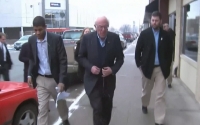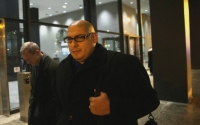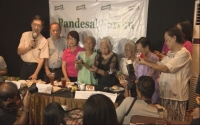Teen inventor uses 3-D printing to revolutionize prosthetics
"I would never have imagined that something I made in my bedroom would be shaking hands with the president," says 17-year-old Easton LaChappelle. But that's exactly what happened when LaChappelle got to visit the White House Science Fair and present the robotic prosthetic arm that he 3-D-printed and built in his bedroom lab.
Kosta Grammatis traveled to LaChappelle's home in Mancos, Colo., to meet the young inventor and find out how he went from Legos to NASA before being old enough to vote.

"I'm hoping to give someone a functional prosthetic arm for under $1,000," LaChappelle declares. The self-taught teen began experimenting with robotic limbs in 2011, when he built his first hand out of Legos, fishing line and servo motors. Frustrated by the high cost of modern prosthetics, he then sought out to develop a more affordable option for amputees.
LaChappelle built his first prototype out of electrical tubing, but for the next one, he sought out more realistic materials. "I wanted to get a more human shape," he explains. "That's a big thing for prosthetics is psychologically, it has to be appealing to the user and also to others."
So he learned modeling software and gained access to a 3-D printer, printing incredibly detailed parts and constructing a functional prosthetic arm that interfaces with the human brain — all in his bedroom. The innovation garnered him public notice for its low production cost, accessibility and functionality, and the teen inventor even got to do his very own TED talk.
"I think a lot more people are taking notice of what he can do on a 3-D printer and realize his vision of making a prosthetic arm at a very low cost," says Patrick LaChappelle, Easton’s father.
"He's a self-starter and he totally figured it out himself,” says Julia Whelihan, his mother. While some parents might be concerned about the amount of time their teen spends alone in their bedroom, it became clear to the LaChappelle’s family that Easton was hard at work on something important. “Apparently his room has become where creativity just took off,” Whelihan laughs. “It was happening right under our nose."

LaChappelle also spent time learning about the functions and limitations of the human hand from Mary Oswald at the San Juan Hand Therapy Clinic.

"I learned from anatomy," LaChappelle explains. "I was trying to understand the human limits of the arm and find all the boundaries. Then I want to capture all of that and eventually, hopefully, surpass human strength."
His determination to learn and innovate impressed Oswald, who appreciates the meaningful impact affordable prosthetics could have for patients in need. "The most meaningful thing that Easton taught me is how a person can go so far with an idea and have that idea turn into something that can help humanity," Oswald says.
LaChapelle's accomplishments helped him land an internship at NASA, where he is working on the Robonaut project at the Johnson Space Center, a dream job for the self-taught lover of robotics.
"If I can go through my life doing what I'm doing now, that would be a dream," LaChappelle says. Changing thousands of lives would just be the icing on the cake.
Watch "TechKnow," Sundays at 7:30PM ET/ 4:30PM PT on Al Jazeera America.















Error
Sorry, your comment was not saved due to a technical problem. Please try again later or using a different browser.